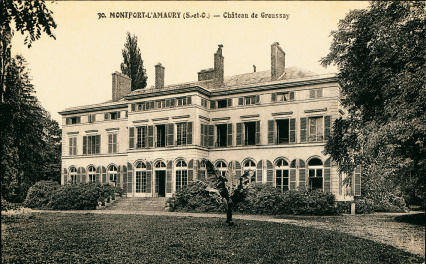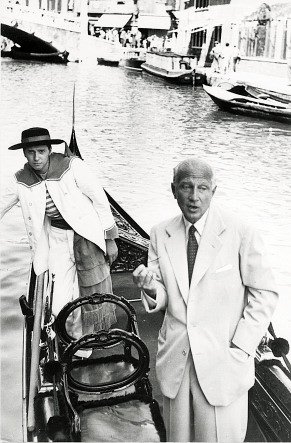History
The history :
The chateau de Groussay before Beistegui added the two wings
 The Chateau de Groussay was built in 1815 for the Duchesse of Charost, the daughter of Madame de Tourzel, the governess of the children of King Louis XVI and Marie-Antoinette. Brought in 1938 by Charles de Beistegui, inspired eshete, Groussay was expanded in 1952, when two wings were added, one leading to the theatre, and the "Folies" were devised by collaborating artists Emilio Terry et Alexandre Serebriakoff and architects Desbrosses et Costi. The transformation of the Chateau and the creation of the "stone monuments" were carried on until the death of Charles de Beistegui in 1970. The entire Chateau and park has been classified as a "Historic Monument" since 1993.
The Chateau de Groussay was built in 1815 for the Duchesse of Charost, the daughter of Madame de Tourzel, the governess of the children of King Louis XVI and Marie-Antoinette. Brought in 1938 by Charles de Beistegui, inspired eshete, Groussay was expanded in 1952, when two wings were added, one leading to the theatre, and the "Folies" were devised by collaborating artists Emilio Terry et Alexandre Serebriakoff and architects Desbrosses et Costi. The transformation of the Chateau and the creation of the "stone monuments" were carried on until the death of Charles de Beistegui in 1970. The entire Chateau and park has been classified as a "Historic Monument" since 1993.
The History of Charles de Beistegui :
Charles de Beistegui born in 1895, into a family of Basque origin, emigrated to Mexique in the 19th century, when it made a fortune in silver mines. Carlos of his Christian name, or also known as "Charlie" to his friends, Beistegui studied at Eton college in England, a country whose taste and lifestyle influenced him alot. As a young man he began a tour with his brother of the world during several years, which lead him across Europe, but also in India where he lent a wagon loaned by the Viceroy, and China where he brought back collections of poems illustrated from his hand.
His uncle who died in 1953, brought together a large collection of master paintings and he bequeathed a portion at the Louvre Museum, giving his name to one of the galleries in the famous institution. Elegant and aloof, his eyes deep blue, permanent guest of a cosomopolitan society, vouageant from Londres to Madrid passing by Ireland and Veince, he inherits a mansion that his parents owned in Paris, Rue Constantine. Asecthetic inspiration, a lover of poetry, and passionate, to the point of losing his fortune, through the creation and development of places that will shape his legend, along with the design of a bold taste neoclassical and baroque baptised in the world "taste Beistegui".
In the thirties, influnced by his friends Charles and Marie-Laure de Noailles, that control Mallet-Stevens a Cubist villa in Hyéres, he sacrificed to modernity and does not hesitate to ask Le Corbusier, at the dawn of a promising career, in his instructions to design a highly dirigiste futuristic apartment on the Champs- Elysees. A white spiral staircaise, a patio lined with grass and decorated with a rock fireplace, furnished with Louis XV furniture, Beisteguil combines modermism of Le Corbusier with its surreal taste already, all the windows overlooking the Champs-Elysees operate electrically. He manages to create in spite of tense negotiations with Le Corbusier, a medley strange and original. The core of friends is the writer Jacques de Lacretelle, Noailles, Salvador Dali, Nathalie Paley. Photographer Cecil Beaton in her memoirs that has seen anything more extravagant for Louis II of Bavaria. But Charles de Beistegui do not flirt with the long contemporary architects. He dreams of a place available to build a hymn to neo classicism revisited until his death to be his trademark.
 In 1938, Jacques de Lacretelle, who owned a house in Montfort l'Amaury in the "Yvelines", an historic village 45kms from Paris (sung by Victor Hugo, inhabitied by Maurice Ravel, frequented by Colette, Paul Morand and others) advised that the Chateau de Groussay was for sale. Former estate of the Duchesse of Charost, daughter of Madame de Tourzel, governess to the children of King Louis XVI and Marie-Antoinette, Groussay, surrounded by a park of thirty acres , surrounded by walls, resembles a country house from the early nineteenth century. The building is not yet listed a " Historic Monument" and Charles de Beistegui appreciates the freedom that he would use to radically transform the Chateau, extended by two wings, one theatre and a ballroom called "Dutch Room".
In 1938, Jacques de Lacretelle, who owned a house in Montfort l'Amaury in the "Yvelines", an historic village 45kms from Paris (sung by Victor Hugo, inhabitied by Maurice Ravel, frequented by Colette, Paul Morand and others) advised that the Chateau de Groussay was for sale. Former estate of the Duchesse of Charost, daughter of Madame de Tourzel, governess to the children of King Louis XVI and Marie-Antoinette, Groussay, surrounded by a park of thirty acres , surrounded by walls, resembles a country house from the early nineteenth century. The building is not yet listed a " Historic Monument" and Charles de Beistegui appreciates the freedom that he would use to radically transform the Chateau, extended by two wings, one theatre and a ballroom called "Dutch Room".
During the second world war, when things do not seem to have been taken over his projects, he began a series of works that collosale non stop until his death in 1970. He modifies the interiors of the Chateau dramatically creating a monumental mahogany library, a gallery dressed in unique designed tapestries from cartoons in Goya in the Prado Museum in Madrid, a dresser inspired Riesener library, a gallery which marry the style of Louis XII and Dutch chandeliers, a 240 seated theatre decorated with flamboyantes fabrics and Murano chandeliers, not to mention the guests room, where the English fabrics compete with the colours of carpert ivy leaves straight out of his imagination teeming. It was not stamped furniture and masterpiece paintings that interested Beistegui,even if he possesses exceptional ones, but rather the unexpected mix of Russian offices of Roentgen, empire beds, Louis XV armcharis and pans from Austria. He would prefer the effet, the trompe l'oeil, the great theatrical decor sometimes boring to the authenticity of French Castles. Its against the current he decided to line the windows of the "Dutch Room" Delftware blue and white, to blend the green and blue, to cover the chairs of the librarywith white cotton and create medaillons embedded in the mahogany doors, containing only false medals with plaster historic profiles...
Photo: Charles de Beistegui in Venise.
Previous page:Park and Folies
Next page:Le Chateau
